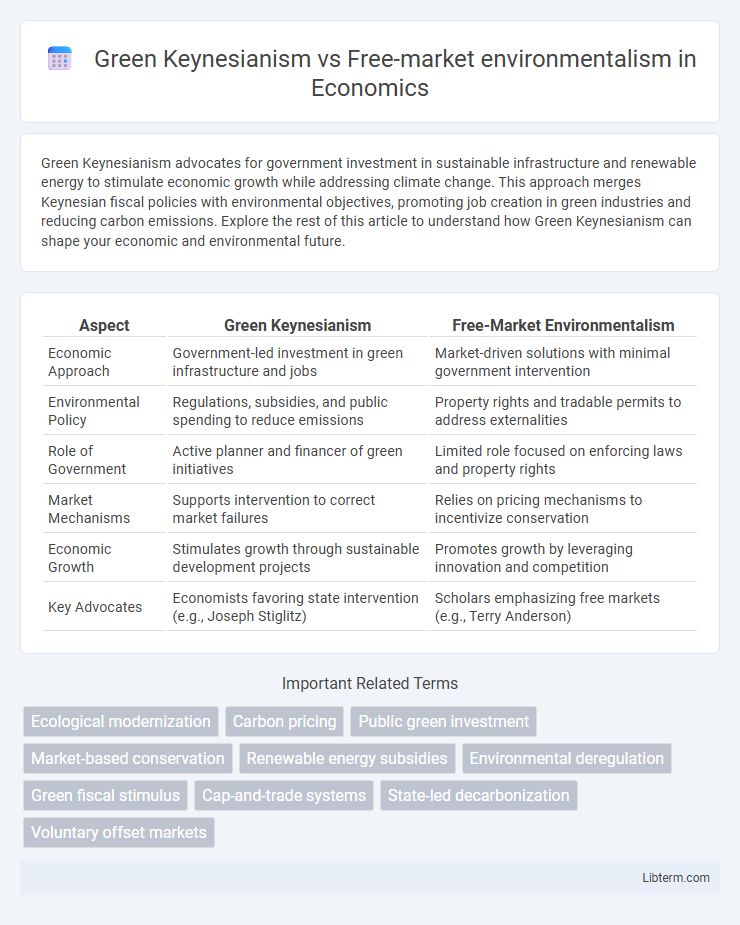Green Keynesianism advocates for government investment in sustainable infrastructure and renewable energy to stimulate economic growth while addressing climate change. This approach merges Keynesian fiscal policies with environmental objectives, promoting job creation in green industries and reducing carbon emissions. Explore the rest of this article to understand how Green Keynesianism can shape your economic and environmental future.
Table of Comparison
| Aspect | Green Keynesianism | Free-Market Environmentalism |
|---|---|---|
| Economic Approach | Government-led investment in green infrastructure and jobs | Market-driven solutions with minimal government intervention |
| Environmental Policy | Regulations, subsidies, and public spending to reduce emissions | Property rights and tradable permits to address externalities |
| Role of Government | Active planner and financer of green initiatives | Limited role focused on enforcing laws and property rights |
| Market Mechanisms | Supports intervention to correct market failures | Relies on pricing mechanisms to incentivize conservation |
| Economic Growth | Stimulates growth through sustainable development projects | Promotes growth by leveraging innovation and competition |
| Key Advocates | Economists favoring state intervention (e.g., Joseph Stiglitz) | Scholars emphasizing free markets (e.g., Terry Anderson) |
Introduction to Green Keynesianism and Free-Market Environmentalism
Green Keynesianism advocates for active government intervention and public investment to promote sustainable economic growth and environmental protection, emphasizing policies like green infrastructure spending and renewable energy incentives. Free-market environmentalism relies on property rights, market mechanisms, and minimal regulation to address environmental issues, arguing that market forces better allocate resources and innovate solutions. Both frameworks prioritize environmental sustainability but diverge fundamentally in their approaches to economic regulation and the role of the state.
Core Principles of Green Keynesianism
Green Keynesianism centers on government intervention to stimulate economic growth while promoting environmental sustainability through large-scale public investments in clean energy and green infrastructure. It emphasizes regulatory frameworks and fiscal policies aimed at reducing carbon emissions and fostering a low-carbon economy. Public sector spending and job creation in renewable energy sectors are core to balancing economic stability with ecological preservation.
Foundations of Free-Market Environmentalism
Foundations of Free-Market Environmentalism emphasize property rights, market incentives, and decentralized decision-making as key mechanisms for environmental protection. This approach argues that when individuals or firms have clear ownership over resources, they are incentivized to manage them sustainably and innovate environmentally friendly solutions. Empirical evidence suggests that well-defined property rights and market-based instruments can effectively address issues like deforestation, pollution, and overfishing without extensive government intervention.
Policy Mechanisms: Government Intervention vs Market Solutions
Green Keynesianism advocates for government intervention through fiscal policies, such as green stimulus spending and environmental regulations, to drive sustainable economic growth and reduce carbon emissions. Free-market environmentalism emphasizes market-based solutions like tradable pollution permits, property rights, and carbon pricing to incentivize businesses and individuals to innovate and minimize environmental harm. These contrasting policy mechanisms reflect the debate between state-led environmental governance and decentralized market-driven approaches for addressing climate change.
Economic Growth and Environmental Sustainability
Green Keynesianism advocates for government investment in green technologies and infrastructure to stimulate economic growth while reducing carbon emissions, prioritizing sustainable development through regulatory frameworks and fiscal policies. Free-market environmentalism emphasizes market-based solutions, property rights, and minimal government intervention, arguing that economic growth and environmental sustainability are achievable through innovation and efficient resource allocation driven by supply and demand. Both approaches seek to balance economic growth and environmental sustainability but diverge on the role of government versus market mechanisms in achieving these goals.
Role of Innovation and Green Technologies
Green Keynesianism emphasizes government-led investment in green technologies and innovation to drive sustainable economic growth and achieve climate goals, advocating for subsidies, R&D funding, and regulatory support. Free-market environmentalism focuses on market-driven innovation, encouraging private sector competition and property rights to foster efficient development and deployment of green technologies without heavy government intervention. Both approaches recognize the critical role of technological advancement but differ in the mechanisms through which innovation is incentivized and scaled.
Addressing Market Failures: Carbon Pricing, Subsidies, and Regulation
Green Keynesianism advocates for robust government intervention through carbon pricing, targeted subsidies for renewable energy, and stringent environmental regulations to correct market failures caused by negative externalities like pollution. Free-market environmentalism emphasizes property rights and market-based mechanisms, arguing that clear legal frameworks and limited state interference can incentivize innovation and efficient resource use without heavy-handed regulations. Both approaches aim to internalize environmental costs but diverge on the appropriate balance between regulatory oversight and market freedom.
Case Studies: Global Implementation of Both Approaches
Green Keynesianism has been effectively implemented in the European Union's Green Deal, driving massive public investments in renewable energy and sustainable infrastructure to stimulate economic growth while reducing carbon emissions. In contrast, Free-market environmentalism is exemplified by the United States' cap-and-trade system in California, where market-based mechanisms create economic incentives for businesses to innovate and reduce pollution. Both approaches highlight diverse strategies for achieving environmental goals: government-led investment versus market-driven solutions, with varying degrees of success across different global contexts.
Criticisms and Limitations of Each Framework
Green Keynesianism faces criticism for potentially leading to inefficient government intervention and increased public debt without guaranteed environmental benefits, while Free-market environmentalism is challenged by its reliance on well-defined property rights and market mechanisms that may fail in addressing public goods and externalities. Critics argue that Green Keynesian policies can create bureaucratic delays and misallocate resources, whereas Free-market environmentalism may overlook social equity and underestimate the scale of environmental degradation requiring coordinated regulation. Both frameworks exhibit limitations in effectively balancing economic growth with sustainable environmental outcomes.
Future Outlook: Synergies and Pathways for Sustainable Development
Green Keynesianism promotes government-led investments in renewable energy and infrastructure to drive economic growth while reducing carbon emissions, emphasizing fiscal policies for sustainable development. Free-market environmentalism relies on property rights, market incentives, and innovation to address environmental challenges, encouraging private sector solutions and cost-effective resource management. Combining these approaches can create synergies where public investment catalyzes market-driven innovation, enabling scalable clean technologies and efficient environmental governance for a sustainable future.
Green Keynesianism Infographic

 libterm.com
libterm.com